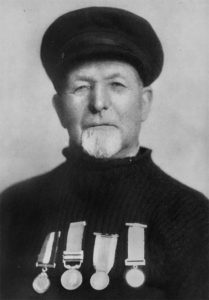Over the weekend of November 19th to the 21st, 1916, two large steamships went ashore on the Goodwin Sands. Volunteers went to Kingsdown to launch the lifeboat situated there, which was considered to be in a more favourable position compared with the North Deal lifeboat, to help launch due to the wind being south-south-west. From 1912 to 1933, there had not been a lifeboat situated at Walmer lifeboat station due to its withdrawal by the Royal National Lifeboat Institution.

Unfortunately due to the heavy seas the Kingsdown lifeboat was unable to fully launch and was constantly driven back ashore, while also being swamped with water and could not be launched again. A crew was formed at North Deal and the Charles Dibdin lifeboat was launched at 10.30pm under the command of Coxswain William “Bill” Adams. The lifeboat headed to the stranded 2,935 tons, 100 metres long vessel ’Val slice’ of Spezia, Italy, which had become stranded while en route from Sunderland to Savona with a cargo of 4,000 tons of coke and coal and a complement of thirty crew and officers.
The lifeboat successfully veered down and got alongside to rescue the entire crew. A H.M. Guardship in the Downs helped with the incident during absolute darkness with aiding the crew using a searchlight. The incident is considered as the first case on record a lifeboat rescue was made being assisted by a searchlight.
Soon after the Charles Dibden had come ashore at North Deal with the thirty men, who had been rescued from the Val Salice, signals of distress were then seen coming from another large steamer, the 11,284 tons steamer ‘Siberia’ of New York, which had gone ashore on the south-west part of the Goodwin Sands, close to the remaining wreck of the Val Salice. Another crew was mustered to launch the North Deal Reserve lifeboat, Francis Forbes Barton, under the command of Coxswain William Stanton. The lifeboat was aided to the rescue with a town from a tug close to the area, before letting go her anchor and veered down to the Siberia.
Four initial attempts were made to get alongside the stranded vessel, but each time the lifeboat could not manage the procedure due to the gale and tremendously heavy sea. This caused the lifeboat to almost capsize on three occasions, with the fourth attempt causing the masts to go under the water, the lifeboat re-righting herself lifting up her mizzen, tearing it clean out with the thwart that supported it, all the while the crew found it difficult to prevent themselves from being washed away. Two men were injured in the absolute turmoil and the decision was made to return to station.

Ramsgate lifeboat had also been launched to the aid of the Siberia, being towed to the Goodwin Sands by a tug, but again it proved almost impossible to reach the stranded vessel. A further attempt was made to launch the Kingsdown lifeboat, with volunteers from Deal launching at 7pm the following day, and was towed by a Royal Navy vessel. The Kingsdown lifeboat ‘Charles Hargreave’ was eventually successful in rescuing the sixty-eight men back to the safety of the shore.
The Deal, Walmer & Sandwich Mercury reported in the newspaper in December 15, 1917, “Medals for Kingsdown lifeboatmen – The Board of Trade have received, through the Foreign Office two gold medals which have been awarded by the President of the United States to James Pay, Coxswain, of the Kingsdown lifeboat, in recognition of their services in rescuing the crew of the American steamship ‘Siberia’ on Nov. 20th, 1916”.
Coxswain Adams was recognised for his efforts during the incident by the RNLI with a clasp added to his existing Institution’s silver medal, which had been awarded for a previous rescue. The Italian Government chose to award Coxswain Adams and his crew with medals and diplomas to commemorate the occasion, with a presentation made by Captain Ranneri Biscia of the Italian Royal Navy, the Navy Attache acting on behalf of the Ambassador, the ceremony taking place in the Deal Town Hall on August 9, 1924.
Colin Varrall
